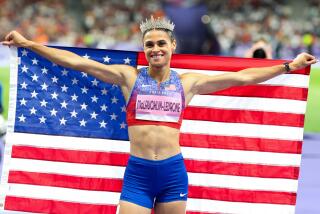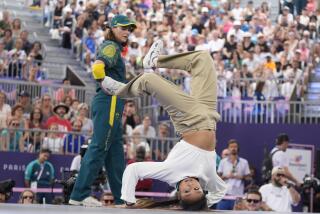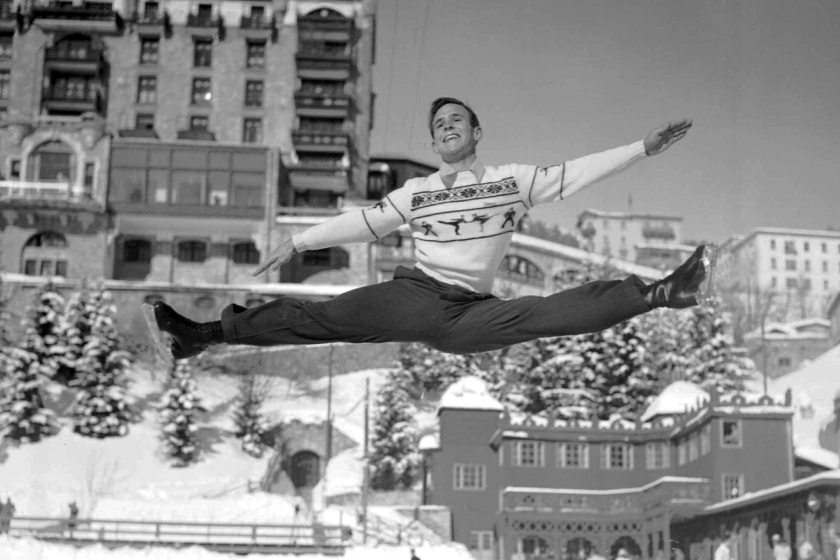RUNNING FOR ITS LIFE
- Share via
ATHENS — If, as the great boxer said, you can run but you can’t hide, how does one explain track in the United States?
Think back. It was on television, briefly, about a year ago. Some guy in gold shoes ran really fast. Twice. Some woman with really long fingernails won another race in a photo finish. Somebody named O’Brien won the event that made Bruce Jenner famous.
For the record:
12:00 a.m. Aug. 9, 1997 Clarification
Los Angeles Times Saturday August 9, 1997 Home Edition Sports Part C Page 4 Sports Desk 2 inches; 57 words Type of Material: Correction
Track and field--A story in Friday’s editions credited Donovan Bailey and Leroy Burrell as the only runners to have run the 100 meters faster than Maurice Greene’s 9.86-second time at the World Championships in Athens. Ben Johnson of Canada ran world-record times of 9.83 seconds in 1987 and 9.79 in 1988, but they later were disallowed when Johnson was found to have used performance-enhancing steroids.
Ring any bells?
Oh, and Carl Lewis was there too.
Still nothing?
Let us review the dossier, then.
There is a group called USA Track & Field, sometimes referred to in inner circles as USATF. It is a clandestine organization specializing in covert operations, among them the acquisition of precious metals, most obtained from such exotic locales as Goteborg, Stuttgart, Rome and Helsinki.
Members are specially trained in the United States and dispatched to various points around the globe.
Many are never heard from again.
How it came to be this way rates as one of the great athletic paradoxes of our generation. The dominant force in international track since the dissolution of the Soviet Union, USA Track & Field seems to be driven deeper and deeper underground at home with every windfall of medals won at a major meet.
The United States led all nations in track gold medals at the Atlanta Olympics with 13--10 more than runner-up Russia--and won 23 medals overall, also best in the world.
Yet, how many Americans know the names of those gold medalists?
Or know that Allen Johnson is the best 110-meter hurdler on the planet--and that he isn’t the younger brother of Michael?
Or know that, among humans, only Donovan Bailey and Leroy Burrell ever ran 100 meters faster than the 9.86-second turbo burst managed by 23-year-old Maurice Greene of Kansas City at the World Championships last Sunday?
Did Greene’s achievement even lead the sports news that night in Kanas City?
Are you kidding?
The Chiefs are in training camp.
NBC-TV is covering these World Championships only on the first and last weekends of the nine-day competition. Midweek television coverage in the United States has been limited to night-owl telecasts on TBS--beginning after midnight on the East Coast.
American athletes have noticed.
U.S. women’s 1,500-meter runner Regina Jacobs complained that her semifinal heat was not shown on U.S. television.
“I think America is kind of confused,” Jacobs said. “They say, ‘Yeah, Regina Jacobs--she’s been No. 1 in the U.S. for three years, a seven-time national champion. Why didn’t we see her run?’ ”
Michael Johnson echoed a longtime complaint when he noted, “We have the fastest athletes in the world. Now it’s up to the federation to market the sport.”
That sounds discus-in-the-face obvious, so simple a solution, but USATF’s ability to turn gold into a virtual media blackout is a running joke on the international track circuit.
Primo Nebiolo, president of the International Amateur Athletic Federation, world track’s governing body, held a news conference this week to announce the organization of an IAAF mercy mission designed to promote track in the United States.
Such missions, Nebiolo said, with no small bemusement, are usually reserved for financially strapped countries and emerging nations--not “the most powerful country in the world. So it could seem ridiculous to go to the U.S. and help them.”
Yes, it could, but at this sorry juncture, USATF is amenable to any and all lifelines Nebiolo might toss its way.
Nebiolo also drew laughs at the expense of former USATF director Ollan Cassell, ousted last year for crimes against marketing, promotion and proper public relations.
“I was for 20 years president of the Italian federation and [track and field] became the second sport in Italy,” Nebiolo said. “Now, in the U.S., track and field is the 25th sport, after billiards.
“I was always believing [Cassell] could face athletics in a different manner. If I had the talents he had in the U.S., and I was there for 20 years. . . .
“I am always dreaming to be young and come back and to be appointed director of U.S. track and field.”
Instead, that daunting assignment has been thrust upon Craig Masback, former champion miler and, most recently, attorney and track television commentator.
Masback has ideas on how to salvage the sport in the United States, most of them likely to annoy the purists, but the purists already know who finished third in the 3,000-meter steeplechase in Bratislava.
Masback needs converts and curiosity seekers, so he proposes:
* More match races along the lines of the Bailey-Johnson 150-meter “world’s fastest human” runoff.
“From every aspect except Michael getting injured, it was a good event,” Masback said. “There was a good crowd, it got super ratings in the U.S. [when you work for USATF, a 4.0 rating qualifies as super]. It was a good live event.”
* Streamlined, made-for-TV meet schedules that can also fit into a family’s afternoon-outing attention span.
“Even when we get people to go to meets, we provide no incentive to make them want to come back,” Masback said. “Meets need to be more streamlined, shorter. You know the old line about indoor track meets being a three-ring circus? Well, too often the three rings are there without the circus. We need to make it entertaining.”
* Gimmicks, gimmicks and more gimmicks. Such as “painting big, different colored swatches on the floor for the shotput. Put five competitors out there and give them two throws each. Stop the other events, put a spotlight on the guys, play music, have them work the crowd and let them go at it, one on one.”
If this sounds too close to WWF territory for comfort, ask the average American on the street whom he’s heard of--Hulk Hogan or John Godina?
(For all you wrestling fans, Godina is the men’s two-time world shotput champion from UCLA.)
*
Along with the radical, Masback also proposes the common-sensical. A coherent U.S. track schedule, for instance, complete with beginning and end, designated “major” tour stops and an “incentive system” designed to guarantee head-to-head match-ups between the top competitors.
“This is not reinventing the wheel,” Masback said. “We know the formula.”
In the meantime, USA Track & Field wraps up the World Championships this weekend with a possible sweep of the four relay gold medals. If you happen across the TV listings, Craig Masback has a polite request:
Please tell a friend.
More to Read
Go beyond the scoreboard
Get the latest on L.A.'s teams in the daily Sports Report newsletter.
You may occasionally receive promotional content from the Los Angeles Times.






